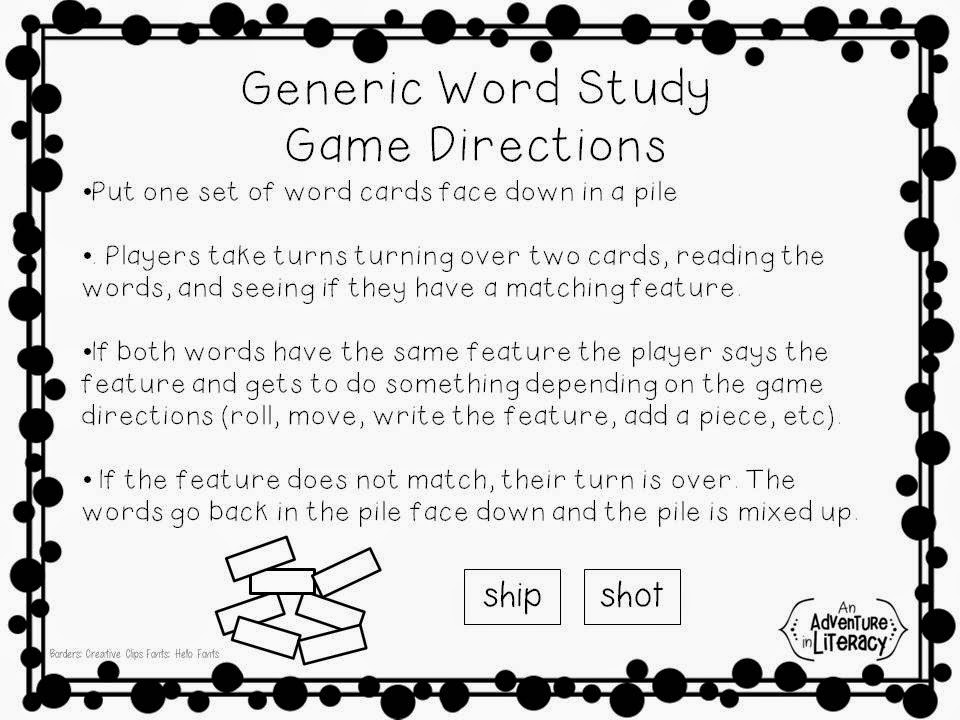Hi! It's Jen from An Adventure in Literacy. I'm here today
to share a few ideas for easy prep word study games you can use with any word
cards or word features. Cathy wrote a great post a few weeks ago on making word study meaningful, so make sure you check out her post if you haven't already.
As a classroom teacher with a zillion things on my to do
list I appreciate easy prep activities. I'm not talking about worksheets that
are print and go, but truly engaging educational activities. If you are
currently using Words Their Way, Word Journeys, or another word study program
then your students already have word cards to use in these game ideas. The
following games are automatically differentiated for each group when the students use
their own word cards to play.
An important part of word study is making sure that students
are understanding the generalizations and features. Traditional spelling activities like rainbow
writing and stamping may be fun for the kids, but true word study games should help
students focus on comparing and contrasting the word features, not just provide memorization practice.
At
the beginning of the year I teach my students the "generic" word
study game rules. Once they understand the concept, this game can be slightly
changed to add new novelty while still keeping the same rules and routines. Here are the basic word study game directions.
Now on to the fun part! Here are a few variations using the basic game directions
and student word cards.
1. Gameboards
When students get a feature match they roll and move on the
game board. I bet every teacher has a bunch of old game boards in your room
that you can turn into word study games.
2. Erasers
Any Target dollar spot addicts out there? When students get
a word feature match they take a fun themed eraser. Whoever has the most at the end wins. Don't these eraser hearts totally look like the real candies?
3. Math Manipulatives
What? Use math manipulatives for word study??? When students
get a word feature match they add a unifix cube to try to see who can get the
tallest stack. Or take a pattern block. Or take a link. You get the idea.
4. Dollar Tree Games
The Dollar Tree is great for having seasonal tic tac toe
games or 2 player plastic race to the top games. When students get a word feature
match they get to place an x or o or move their player forward 1 space.
5. Seasonal Cooperative Games
These take {a little} prep but they are a fun way to have students
work together for a common goal. There is one large paper shape and students
add something to it when they get a feature match. Examples include: a pumpkin
with black triangles to make a jack-o-lantern, a turkey body with feathers, a Christmas
tree with ornaments. If you are fortunate to have large die cuts, they work
great for this. If not, it takes about 5
minutes to cut out a shape.
6. Drawing Games
Recently we played "Do You Want to Build a
Snowman?". Until this year the game was just called "Draw a
Snowman" but the excitement factor got bumped up thanks to Frozen! If
students got a feature match they got to draw a part on their snowman. I just
gave them a blank piece of paper {super low prep} and they got to choose what to add to their
snowman {student choice for high engagement}. These were by no means works of
art, but the kids had fun while practicing their words.
7. Dry Erase Games
Ok, I did make these to use in my class, but once they were made
they became low prep. I just change out the seasonal boards each month. When
students get a feature match they write the feature on the game board in the
dry erase pocket (or page protector). The first player to get to the end or
fill up their side of the board wins. You can grab a free copy of "Shadow Shuffle" because Groundhog Day will be here before you know it!
So there you have it. 7 low prep variations on the same
game, all focusing on word features. I usually provide several of these games as options to give the students
choice. I store them in a 10 drawer cart and change them out monthly. Students
just pick a game, grab their words and play. Easy peasy.
A few closing remarks...
- · Make sure the biggest focus is on word study, not the game. The game should be simple enough to compliment the feature practice.
- · Continually change out the games to keep the students engaged. A lot of these games can be adapted for a holiday or month. Same rules, just a new look.
- · You can add an accountability piece to the games by having students write the words they read on a recording sheet or word study notebook.















































